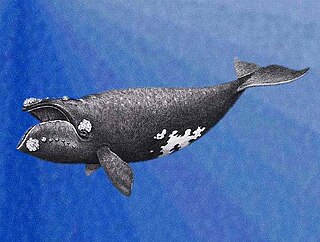Related Research Articles

Noise pollution, or sound pollution, is the propagation of noise or sound with ranging impacts on the activity of human or animal life, most of which are harmful to a degree. The source of outdoor noise worldwide is mainly caused by machines, transport and propagation systems. Poor urban planning may give rise to noise disintegration or pollution, side-by-side industrial and residential buildings can result in noise pollution in the residential areas. Some of the main sources of noise in residential areas include loud music, transportation, lawn care maintenance, construction, electrical generators, wind turbines, explosions and people.

Baleen whales, also known as whalebone whales, are marine mammals of the parvorder Mysticeti in the infraorder Cetacea, which use keratinaceous baleen plates in their mouths to sieve planktonic creatures from the water. Mysticeti comprises the families Balaenidae, Balaenopteridae (rorquals), Eschrichtiidae and Cetotheriidae. There are currently 16 species of baleen whales. While cetaceans were historically thought to have descended from mesonychians, molecular evidence instead supports them as a clade of even-toed ungulates (Artiodactyla). Baleen whales split from toothed whales (Odontoceti) around 34 million years ago.

The humpback whale is a species of baleen whale. It is a rorqual and is the only species in the genus Megaptera. Adults range in length from 14–17 m (46–56 ft) and weigh up to 40 metric tons. The humpback has a distinctive body shape, with long pectoral fins and tubercles on its head. It is known for breaching and other distinctive surface behaviors, making it popular with whale watchers. Males produce a complex song typically lasting 4 to 33 minutes.

Right whales are three species of large baleen whales of the genus Eubalaena: the North Atlantic right whale, the North Pacific right whale and the Southern right whale. They are classified in the family Balaenidae with the bowhead whale. Right whales have rotund bodies with arching rostrums, V-shaped blowholes and dark gray or black skin. The most distinguishing feature of a right whale is the rough patches of skin on its head, which appear white due to parasitism by whale lice. Right whales are typically 13–17 m (43–56 ft) long and weigh up to 100 short tons or more.

The southern right whale is a baleen whale, one of three species classified as right whales belonging to the genus Eubalaena. Southern right whales inhabit oceans south of the Equator, between the latitudes of 20° and 60° south. In 2009 the global population was estimated to be approximately 13,600.

Balaenidae is a family of whales of the parvorder Mysticeti that contains mostly fossil taxa and two living genera: the right whale, and the closely related bowhead whale.

The North Atlantic right whale is a baleen whale, one of three right whale species belonging to the genus Eubalaena, all of which were formerly classified as a single species. Because of their docile nature, their slow surface-skimming feeding behaviors, their tendencies to stay close to the coast, and their high blubber content, right whales were once a preferred target for whalers. At present, they are among the most endangered whales in the world, and they are protected under the U.S. Endangered Species Act and Marine Mammal Protection Act and Canada's Species at Risk Act. There are around 356 individuals in existence in the western North Atlantic Ocean—they migrate between feeding grounds in the Labrador Sea and their winter calving areas off Georgia and Florida, an ocean area with heavy shipping traffic. In the eastern North Atlantic, on the other hand—with a total population reaching into the low teens at most—scientists believe that they may already be functionally extinct. Vessel strikes and entanglement in fixed fishing gear, which together account for nearly half of all North Atlantic right whale mortality since 1970, are their two greatest threats to recovery.

The North Pacific right whale is a very large, thickset baleen whale species that is extremely rare and endangered. On average and maximum weight, they are the second largest whale species in the world.

Whales use a variety of sounds for communication and sensation. The mechanisms used to produce sound vary from one family of cetaceans to another. Marine mammals, including whales, dolphins, and porpoises, are much more dependent on sound than land mammals due to the limited effectiveness of other senses in water. Sight is less effective for marine mammals because of the way particulates in the ocean scatter light. Smell is also limited, as molecules diffuse more slowly in water than in air, which makes smelling less effective. However, the speed of sound is roughly four times greater in water than in the atmosphere at sea level. As sea mammals are so dependent on hearing to communicate and feed, environmentalists and cetologists are concerned that they are being harmed by the increased ambient noise in the world's oceans caused by ships, sonar and marine seismic surveys.
Zoomusicology is the study of the musical aspects of sound and communication as produced and perceived by animals. It is a field of musicology and zoology, and is a type of zoosemiotics. Zoomusicology as a field dates to François-Bernard Mâche's 1983 book Music, Myth, and Nature, or the Dolphins of Arion, and has been developed more recently by scholars such as Dario Martinelli, David Rothenberg, Hollis Taylor, David Teie, and Emily Doolittle.

Ocean acoustic tomography is a technique used to measure temperatures and currents over large regions of the ocean. On ocean basin scales, this technique is also known as acoustic thermometry. The technique relies on precisely measuring the time it takes sound signals to travel between two instruments, one an acoustic source and one a receiver, separated by ranges of 100–5,000 kilometres (54–2,700 nmi). If the locations of the instruments are known precisely, the measurement of time-of-flight can be used to infer the speed of sound, averaged over the acoustic path. Changes in the speed of sound are primarily caused by changes in the temperature of the ocean, hence the measurement of the travel times is equivalent to a measurement of temperature. A 1 °C (1.8 °F) change in temperature corresponds to about 4 metres per second (13 ft/s) change in sound speed. An oceanographic experiment employing tomography typically uses several source-receiver pairs in a moored array that measures an area of ocean.

Whale barnacles are species of acorn barnacle that belong to the family Coronulidae. They typically attach to baleen whales, and sometimes settle on toothed whales. The whale barnacles diverged from the turtle barnacles about three million years ago.

The interactions between marine mammals and sonar have been a subject of debate since the invention of the technology.

The Scotian Shelf is a geological formation, part of the Continental shelf, located southwest of Nova Scotia, Canada. It covers an area of 120,000 square kilometres (46,000 sq mi), is 700 kilometres (430 mi) long and ranges in width from 120 to 240 kilometres. It has an average depth of 90 metres (300 ft). The Scotian Shelf contains the ecologically important Scotian Shelf Large Marine Ecosystem (LME) and the Scotian Shelf Waters (SSW).

Coronula diadema is a species of whale barnacle that lives on the skin of humpback whales and certain other species of whale. This species was first described by Carl Linnaeus in the 1767 12th edition of his Systema Naturae.
Jennifer Miksis-Olds is an American marine scientist known for her research using acoustics to track marine mammals.

Natacha Aguilar de Soto is a Spanish marine biologist at the University of La Laguna (ULL), Tenerife, Canary Islands. She is a Ramón y Cajal research and teaching fellow at ULL and has been a Marie Skłodowska-Curie Research Fellow at ULL and at the Center for Research in Ecological Modeling (CREEM) of the University of St. Andrews (SMRU). She is the director of cetacean research within ULL's BIOECOMAC.
References
- ↑ Parks, Susan Elizabeth (2003). Acoustic communication in the North Atlantic right whale (Eubalaena glacialis) (Thesis). Woods Hole, MA: Massachusetts Institute of Technology and Woods Hole Oceanographic Institution. doi:10.1575/1912/2453. hdl: 1912/2453 .
- ↑ "Curriculum Vitae" (PDF). Syracuse University . March 2018. Archived (PDF) from the original on July 26, 2023. Retrieved July 26, 2023.
- ↑ Bradbury, Kelsey (November 16, 2010). "Catching up with Susan Parks". Penn State News.
- ↑ Parks, Susan E.; Johnson, Mark; Nowacek, Douglas; Tyack, Peter L. (February 23, 2011). "Individual right whales call louder in increased environmental noise". Biology Letters. 7 (1): 33–35. doi:10.1098/rsbl.2010.0451. PMC 3030867 . PMID 20610418.
- ↑ Winner, Cherie (November 10, 2010). "Are Whales 'Shouting' to be Heard?". Oceanus. Woods Hole Oceanographic Institution. Retrieved May 25, 2021.
- ↑ Slivka, Kelly (August 20, 2012). "A Whale, a Tag, a Mission". New York Times. Retrieved May 25, 2021.
- ↑ Root-Gutteridge, Holly; Cusano, Dana A.; Shiu, Yu; Nowacek, Douglas P.; Van Parijs, Sofie M.; Parks, Susan E. (March 1, 2018). "A lifetime of changing calls: North Atlantic right whales, Eubalaena glacialis, refine call production as they age". Animal Behaviour. 137: 21–34. doi: 10.1016/j.anbehav.2017.12.016 . ISSN 0003-3472. S2CID 53145542.
- ↑ Matthews, Leanna P.; McCordic, Jessica A.; Parks, Susan E. (March 19, 2014). "Remote Acoustic Monitoring of North Atlantic Right Whales (Eubalaena glacialis) Reveals Seasonal and Diel Variations in Acoustic Behavior". PLOS ONE. 9 (3): e91367. Bibcode:2014PLoSO...991367M. doi: 10.1371/journal.pone.0091367 . ISSN 1932-6203. PMC 3960123 . PMID 24646524.
- ↑ "Endangered whales are breeding in a busy shipping lane". Futurity. March 26, 2014. Retrieved May 26, 2021.
- ↑ Cusano, Dana A.; Matthews, Leanna P.; Grapstein, Elyna; Parks, Susan E. (2016). "Effects of increasing temperature on acoustic advertisement in the Tettigoniidae". Journal of Orthoptera Research. 25 (1): 39–47. doi: 10.1665/034.025.0101 . ISSN 1082-6467. JSTOR 24892490. S2CID 89187220.
- ↑ Tennessen, Jennifer B.; Parks, Susan E.; Swierk, Lindsey; Reinert, Laura K.; Holden, Whitney M.; Rollins-Smith, Louise A.; Walsh, Koranda A.; Langkilde, Tracy (November 21, 2018). "Frogs adapt to physiologically costly anthropogenic noise". Proceedings of the Royal Society B: Biological Sciences. 285 (1891): 20182194. doi:10.1098/rspb.2018.2194. PMC 6253376 . PMID 30464067.
- ↑ "Traffic noise stresses out frogs, but some have adapted | Penn State University". news.psu.edu. Retrieved May 25, 2021.
- ↑ Matthews, Leanna P.; Fournet, Michelle E. H.; Gabriele, Christine; Klinck, Holger; Parks, Susan E. (April 29, 2020). "Acoustically advertising male harbour seals in southeast Alaska do not make biologically relevant acoustic adjustments in the presence of vessel noise". Biology Letters. 16 (4): 20190795. doi:10.1098/rsbl.2019.0795. PMC 7211458 . PMID 32264795.
- ↑ Parks, Susan E.; Miksis-Olds, Jennifer L.; Denes, Samuel L. (2014). "Assessing marine ecosystem acoustic diversity across ocean basins". Ecological Informatics. 21: 81–88. doi:10.1016/j.ecoinf.2013.11.003.
- ↑ Daley, Jason (October 11, 2019). "North Atlantic Right Whale Mamas Whisper to Their Babies to Keep Them Safe". Smithsonian Magazine. Smithsonian Institution. Retrieved May 25, 2021.
- ↑ Parks, Susan E.; Cusano, Dana A.; Van Parijs, Sofie M.; Nowacek, Douglas P. (October 31, 2019). "Acoustic crypsis in communication by North Atlantic right whale mother–calf pairs on the calving grounds". Biology Letters. 15 (10): 20190485. doi:10.1098/rsbl.2019.0485. PMC 6832179 . PMID 31594493.
- ↑ "Why do whales make 'tick-tock' noises? Find out!". Deccan Chronicle. December 17, 2014. Retrieved May 25, 2021.
- ↑ Parks, Susan E.; Cusano, Dana A.; Stimpert, Alison K.; Weinrich, Mason T.; Friedlaender, Ari S.; Wiley, David N. (December 16, 2014). "Evidence for acoustic communication among bottom foraging humpback whales". Scientific Reports. 4 (1): 7508. Bibcode:2014NatSR...4E7508P. doi:10.1038/srep07508. ISSN 2045-2322. PMC 4267198 . PMID 25512188.
- ↑ Struck, Doug (October 12, 2014). "The whale savers". Christian Science Monitor.
- ↑ Lindsay, Jay (February 20, 2012). "Unplanned 9/11 analysis links noise, whale stress". Washington Post. ISSN 0190-8286 . Retrieved May 26, 2021.
- ↑ Rolland, Rosalind M.; Parks, Susan E.; Hunt, Kathleen E.; Castellote, Manuel; Corkeron, Peter J.; Nowacek, Douglas P.; Wasser, Samuel K.; Kraus, Scott D. (June 22, 2012). "Evidence that ship noise increases stress in right whales". Proceedings of the Royal Society B: Biological Sciences. 279 (1737): 2363–2368. doi:10.1098/rspb.2011.2429. PMC 3350670 . PMID 22319129.
- ↑ Cave, James (January 14, 2015). "The Ingenious Way Humpback Whales Hunt In Pitch-Black Waters At Night". HuffPost. Retrieved May 26, 2021.
- ↑ Lagan, Susan (August 18, 2016). "Female champions of science". The Royal Gazette. Retrieved May 23, 2021.
- ↑ "Four faculty members to receive Presidential Early Career Awards | Penn State University". news.psu.edu. Retrieved May 23, 2021.
- ↑ "President Honors Outstanding Early-Career Scientists". www.nsf.gov. Retrieved May 23, 2021.
- ↑ "Susan Parks". www.nasonline.org. Retrieved May 25, 2021.